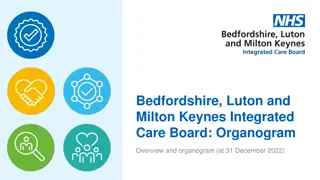Understanding Child and Young People's Health in Milton Keynes City
The Milton Keynes City JSNA Children & Young People Executive Summary highlights key health indicators such as smoking during pregnancy, teenage parenting impacts, obesity risks, and perinatal mental health issues. It also emphasizes the importance of early access to maternity services, breastfeeding rates, childhood vaccination, oral health, and the effects of COVID-19 on child health services. Priority areas for action include improving perinatal mental health services, immunization rates, and responsive services for terminally ill children.
Download Presentation

Please find below an Image/Link to download the presentation.
The content on the website is provided AS IS for your information and personal use only. It may not be sold, licensed, or shared on other websites without obtaining consent from the author. Download presentation by click this link. If you encounter any issues during the download, it is possible that the publisher has removed the file from their server.
E N D
Presentation Transcript
Milton Keynes City JSNA Children & Young People Executive Summary
Milton Keynes City healthy pregnancy snapshot (2019/20) Outcome influencing indicators Health outcome indicators Smoking is the biggest single factor that negatively impacts health in pregnancy. Fewer women in Milton Keynes City , Bedford Borough and Central Bedfordshire are smoking at the time of birth than the average nationally. Infant mortality rate is improving and is now similar in Milton Keynes City compared to similar local authorities based on deprivation. There are fewer premature births in Milton Keynes City per 1,000 births, than the average of similar local authorities based on deprivation. Teenage parenting increases the risk of poorer health outcomes without additional support. Historically, the rate of conceptions in under 18s has been worse in Milton Keynes City than in similar local authorities The percentage of babies with a low birth weight in Milton Keynes City is worse than the national average but there are significant variations across wards Early access to maternity services improves birth outcomes. Approaching 6 in 10 pregnant women accessed maternity care early (within 10 weeks of pregnancy). This is better than similar local authorities Obesity during pregnancy increases the health risks for both the mother and child. Over 1/2 thefemale adults in Milton Keynes City are classified as overweight or obese More than 1 in 10 women nationally are affected by perinatal mental health issues Priority areas for action Perinatal mental health services Communication & co-ordination among service providers Maternal obesity Target wards with higher levels of deprivation and inequalities Effects of COVID-19: Improved attendance levels for virtual consultations Increased isolation and loneliness
Milton Keynes City healthy birth & early years snapshot 2019/20 Risk factor indicators Breast feeding is linked to lower the rates of gastroenteritis, respiratory infections, sudden infant death syndrome, obesity and allergies. More mothers are breastfeeding in Milton Keynes than the average in England and numbers are increasing markedly Outcome indicators The rate of A&E attendances in children aged 0-4 years has increased from the previous year and remains better than similar local authorities based on deprivation. Vaccination is recognised as one of the most effective public health interventions in the world. Milton Keynes is consistently above the comparators but is below the national 95% target for two doses of MMR vaccine The rate of admissions for lower respiratory tract infections in infants under 1 year old has decreased butis worse than deprivation comparators. The admissions rate for gastroenteritis in 1 year olds is decreasingbutworse than than similar local authorities based on deprivation. Poor oral health can affect a child s ability to speak, eat, sleep, play, socialise, and can negatively impact on their school attendance and wellbeing. Hospital admissions for dental carries is improvingbut is worse than the national average The proportion of 5 year olds reaching a good level of development at the Early Years Foundation stage stayed the same andis in line withthan similar local authorities based on deprivation. Adverse Childhood Experiences or traumatic events, such as domestic abuse increase the risk of high-risk behaviours and poorer outcomes as adults. The rate of domestic abuse incidents per 1,000 is worseningbut remains better than the national average Effects of COVID-19 Reductions in postnatal midwifery and health visitor s home visits Service changes most likely disproportionately impacted children from the poorest families, or those with other vulnerabilities and particular needs. Priority areas for action Improve immunisation rates through communication & co- ordination improvements, plus promotion through traditional and social media channels and trusted voices. Responsive 7-day services Information and care pathway for terminally ill children
Milton Keynes City school-aged years snapshot 2019/20 Risk factor indicators Outcome indicators Compared to similar local authorities based on deprivation, hospital admissions due to: Obese children have a higher risk of poor health, disability and premature mortality in adulthood and potentially poorer teenage mental health Over 1/5 of all Reception children are Obese, better than the national average At Year 6 that proportion remains better than the national average, but increased to around 1/3 Self-harm in young people aged 10 to 24 years reduced and remains better Mental health conditions for those aged 0 to 17 increased and is now worse Alcohol-specific conditions for those under 18 decreasedand remains better Substance misuse for those aged 15 to 24 decreased and remains better Unintentional and deliberate injuries in those under 14, decreasedand remains better Asthma for those under 18 decreased butis worse Children suffering from poor mental health are at risk of poor physical health outcomes, poor educational attainment, and are at greater risk of unhealthy behaviours. A lower proportion of school pupils in Milton Keynes City have social, emotional and mental health needs than the average for similar local authorities based on deprivation Milton Keynes City has a similar number or decayed, missing or filled teeth per child as the national average Smoking is a major cause of ill health, particularly heart and lung disease and many people who start smoking as adolescents continue to smoke into adulthood. The prevalence of smokers in Milton Keynes City s children under the age of 15 is above the national average The average Attainment 8score at 15-16 years old improvedbut remains worse than similar local authorities based on deprivation Priority areas for action Empower communities to address risk taking behaviours Provide more intensive community support allowing CAHMS to focus on highest risk and explore step up step-down intensive day care beds The effects of COVID-19: Increased prevalence of mental health (especially eating disorders), learning disabilities and autism and resulting pressure on services Risk of safeguarding concerns not being raised























